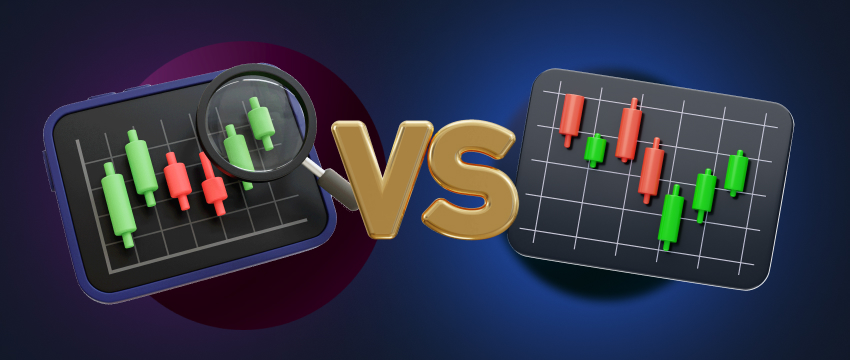People most commonly mention day trading と scalping as forex trading tactics online. A lot of people like to recommend them, with some even going as far as to say that you can’t lose using them. This is, of course, false, but there are also valid reasons to like these strategies.
The feedback is near instant, in that you know whether you’ve won or lost within the span of a day, they are intense, exciting, and feel rewarding to pull off well. However, one fact that people often keep silent in an attempt to drag in new traders is that these tactics are also difficult.
Day traders, even though their sessions may not be as long, need to stay on top of reports and key news constantly. Meanwhile, scalpers operate in shorter bursts but need to be correct in a majority of their trades to remain profitable.
In this article, we’ll pit day trading and scalping against each other and see which trader may get the most out of which tactic.
What is scalping and day trading?
What is Scalping in Trading?
Scalping is a high-intensity trading tactic that aims to employ a high volume of transactions with short timeframes (seconds to minutes). Most scalpers aim for incremental wins and try to amass profits with quantity. It requires quick decision-making and high stress tolerance and can be mentally fatiguing.
It’s also important to note that scalping also requires a lot of physical dexterity. There’s a lot of clicking, it requires good timing and reflexes, and good multitasking skills are needed to keep up with small, precise increments on multiple trades.
The Broader Scope of Day Trading
Day trading is slightly deceptive, in that it doesn’t refer to a single tactic. Instead, it refers to a group of trading strategies that aims to open and close trades within the same day. In fact, scalping is also categorised as short-term investing.
However, scalping has become well-known (or notorious) enough to somewhat separate itself from the rest of the category.
When most people think of day trading, they think of multi-hour trade-based, trend-seeking, news-following strategies.
Comparing Intensity and Research
As mentioned, these are less intense than scalping on the execution side but require much more research time. Since a lot of short-term investing tactics are based on news and premarket or market data, day traders have a lot to keep track of.
Additionally, while scalping can be applied to a preferred asset at any time, day trading may not always be feasible if there is little to no market movement on a given day. This means that day traders may be required to step out of their comfort zone and expand their knowledge often.
The next part will give a more detailed information on the specific routines and tools traders employ for デイトレード と scalping. This will paint a clearer picture on how an actual trading routine looks like for these two strategies.

Scalping
Scalping is a highly intense trading strategy, requiring tight execution and meticulous focus. It is often promoted as a tactic for those who aren’t highly interested in investing.
In fact, scalpers, in theory, can succeed without any trading knowledge at all. Of course, that makes it much more difficult.
Why Forex is the Scalper’s Playground
As noted above, scalpers like to enter and exit trades precisely and quickly. For this, most scalpers flock to the forex market, as it’s among the most active.
In particular, forex majors (and to a lesser extent, minors) hold interest for scalpers. It’s a highly reactive market open 24/5, has high trading volumes, and is extremely liquid.
As such, scalpers are able to enter and exit trades on the exact pip they are aiming for. Some scalpers also aim for large-cap stocks, as they offer similar benefits to them that the forex market does.
Tools, Timing, and Scalper Conditions
Scalpers also react quickly. They often use DMA platforms, level II quotes, and order book depth functions.
That way, they can gain full market insight and be sure that their trades will be executed exactly as they planned.
Similarly, hotkey setups are crucial for quickly operating with multiple assets in single-second timeframes.
And of course, these single-second timeframes are what scalpers often use. Since they only aim for 5-10 pip increments, it’s crucial that they see even the slightest movement.
Doing so on multiple assets at once is quite difficult and is one a key part of mastering scalping.
For market conditions, scalpers aim for times of increased price movement and high activity. These produce the perfect situation, where it’s possible to find transactions where assets have moved incrementally while.
As such, volatility (moderate, not hectic), and periods of increased volume (news, reports, market opening) are perfect.
Scalping: Final considerations
It’s also extremely important to note that, since scalpers open a lot of trades, they pay a lot of trading fees. They usually aim for accounts where there aren’t any flat fees (since these often negate any profit) and aim for tighter spreads.
Lastly, a key detail to mention is that not all brokers allow scalping. Some have it in their T&C, and some just have a built-in time requirement between buying and selling.
If you are a scalper or intend to try scalping, it’s extremely important for you to verify if it’s okay with your forex broker. Otherwise, you may get your account shut down.

Day Trading
As mentioned earlier, day trading consists of a set of tactics rather than a single unified strategy. Therefore, it will be examined differently compared to scalping.
Common characteristics of most short-term investing tactics will be outlined first, followed by a review of specific strategies by name.
Scalping and day trading (unsurprisingly, since the former fall under the latter) share a lot of qualities. For instance, both like the same markets (株式, 外国為替) and similar conditions (volatility, high activity). However, the trading feel is quite significantly different between these two.
Namely, while scalpers are looking for spikes or drops in value, day traders are taking a more qualitative approach.
They aim to ride longer trends and find trades with a good risk-reward ratio instead of something they can profit from immediately. The approach is much more analytical and much less physically demanding.
Day traders usually aim for frames of a few minutes to a few hours, depending on the specific tactic.
Essentially, they aim to ride out inter-day market trends, often exiting before markets close. The interesting thing about day trading is that it can easily transition to a more traditional buy-and-hold format simply by not selling within the same day.
As such, flexible day traders sometimes step out of their strategy to get the most out of a trade. Most day traders prefer the same spread-based pricing structure as scalpers do.
However, for those with a particularly high trading volume, ECN, zero-spread accounts may be more beneficial.
Key day trading tactics:
Momentum trading
Jumping on assets under the influence of a powerful driver. News, volume, excitement, or fear are all things that momentum traders look for.
Breakout trading
Entering positions for assets that have broken through a key support or resistance level. This often causes a strong movement, which day traders aim to capitalise on.
Reversal trading (mean reversion)
Aims to spot market reactions and profit from the correction. Traders use tools like RSI and volume exhaustion indicators to spot trading opportunities.
Gap and go
A trading tactic that rides premarket trends. Traders ride the energy released when markets open which often creates trends lasting a few hours.
Catalyst Trading
Informed, analytical traders trade around key info releases. It’s similar to momentum trading, but has a more predictive element to it, often increasing both risk and potential reward.

Day trading or scalping: Which should you choose?
The answer, surprisingly, is very simple: whichever one you prefer. Trading is a highly personal matter, and different styles see vastly different success from trader to trader.
Perhaps you’re a gamer with sharp reflexes and high precision who doesn’t want to spend hours researching assets. In that case, you’ll most likely find yourself attracted to scalping. On the other hand, maybe you’re more old-school and prefer to take your time and measure out your actions.
In that case, it’s more probable you’ll find yourself in day trading. Additionally, there’s no need to pick one. If both sound interesting, you can incorporate both, see what works for you, and create a personalised overreaching strategy.
Remember, trading is highly versatile, and traders who create a plan based on their own merits often outperform those who follow strict guidelines.
Disclaimer: This material is for general informational and educational purposes only and should not be considered investment advice or an investment recommendation. T4Trade is not responsible for any data provided by third parties referenced or hyperlinked in this communication.





